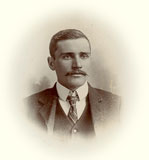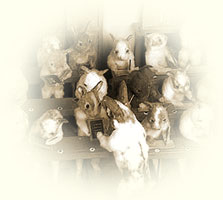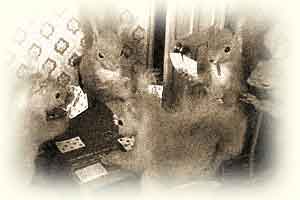 Dr. Peter Hughes of Trinford (1862-1908), in addition to his humdrum duties as a smalltown medical practitioner, was also an enthusiastic amateur taxidermist who constructed a vast quantity of novel and elaborately detailed tableaux featuring dressed and posed stuffed animals. This was a fairly widespread hobby in the nineteenth century - see the works of Walter Potter1, Edward Hart,2 and others, even though the whole thing smacks of wanton cruelty to modern sensibilities.
Dr. Peter Hughes of Trinford (1862-1908), in addition to his humdrum duties as a smalltown medical practitioner, was also an enthusiastic amateur taxidermist who constructed a vast quantity of novel and elaborately detailed tableaux featuring dressed and posed stuffed animals. This was a fairly widespread hobby in the nineteenth century - see the works of Walter Potter1, Edward Hart,2 and others, even though the whole thing smacks of wanton cruelty to modern sensibilities.
 Dr. Hughes favoured the recreation of scenes from literature and fable, and current events, and his tableaux were immensely popular for a short while, being featured in contemporary popular publications such as Pearson's Magazine, and The Strand Magazine and similar publications. His most well-known was his 'House of Commons', which featured over three hundred vigorously gesticulating rabbits and kittens (representing Liberals and Tories respectively), and which can still be seen by special request at the Trinford County Museum, while his monumental diorama, 'The Battle of Isandlwana' - which sacricifed no less than 112 black kittens to represent Cetewayo's Zulus - met with considerable popular acclaim.3
Dr. Hughes favoured the recreation of scenes from literature and fable, and current events, and his tableaux were immensely popular for a short while, being featured in contemporary popular publications such as Pearson's Magazine, and The Strand Magazine and similar publications. His most well-known was his 'House of Commons', which featured over three hundred vigorously gesticulating rabbits and kittens (representing Liberals and Tories respectively), and which can still be seen by special request at the Trinford County Museum, while his monumental diorama, 'The Battle of Isandlwana' - which sacricifed no less than 112 black kittens to represent Cetewayo's Zulus - met with considerable popular acclaim.3
But there was a darker side to Dr. Hughes' taxidermy, which did not come to public notice during his lifetime. He had a number of wealthy admirers of his work who were willing to pay handsomely for various 'special' tableaux to be constructed to their particular specifications. These custom works were never intended for general viewing, and included the following unconventional examples of the taxidermist's art:
- A series of dioramas inspired by De Sade's 'Juliette' in which the unfortunate heroine is represented by a tabby cat and her tormentors by sadistic rabbits, constructed for Lord Bangor, and sadly destroyed in 1917 by order of Lord Bangor's widow.
- Twelve scenes from the works of children's author Beatrix Potter, constructed for a Mr. Hertz of Iowa, which depicted the author's familiar squirrels and bunny rabbits being imaginatively abused by foxes and cats (five of these scenes are known to have survived, but have disappeared into private collections) 4.
- A madly ambitious series of twenty-four very large cased tableaux commissioned by the Marquis of Bathgate, which were to recreate in detail various key scenes from De Sade's seminal '120 Days of Sodom', using red squirrels and ginger kittens and a vast quantity of meticulously constructed accessories. Only seven were completed at the time of Hughes' untimely death in 1908, two of which were destroyed by his executors before they discovered how much their commissioner had agreed to pay for what they considered 'obscene and disturbing'. Unfortunately, the Marquis of Bathgate's large collection of animal-related erotica5 was broken up following his death in the First Somme and the current whereabouts of the various pieces are completely unknown.6
Addendum (Feb 6th 2004): Adrian Vonner 7 emailed me to say that the late Nikolai Beria, Stalin's secret police chief, is said to have possessed several novel tableaux mainly employing arctic foxes and mink, constructed for him by labour camp inmates. He adds that the scurrilous story that Beria derived sexual pleasure from forcing young women to dress in animal costumes is, sadly, completely untrue.

1. Artist and taxidermist, born 1835, Bramber, Sussex. His collection has recently been broken up and auctioned off.
2. Edward Hart (1847-1928), son of William Hart, a Christchurch taxidermist.
3. See Smythe, Bart; "British Imperialism in Popular Culture", p. 327 (Clutterbuck, 1958)
4. I am informed that "The Ravishment of Miss Jemima Puddleduck" was sold at auction in 2002 in Columbus, Ohio, USA to an anonymous buyer who paid $3,500.
5. This has nothing to do with bestiality, and was instead manifested as a keen interest in the the erotic possibilities of anthropomorphised animals and animal-human hybrids, in the visual arts and literature. It eerily foreshadows certain modern interests and lends new truth to the cliché that "there is nothing new under the sun".
6. Two of the pieces are reportedly in the possession of a private collector in the USA.
7. Author of several German-language articles dealing with the interesting topics of otherkin and therianthropy from a Jungian viewpoint, and creator of the cult animation, "The Bear and the Wedding Dress: A Silesian Folktale". Currently researching the possible application of Orgone Therapy to the treatment of species dysphoria.
Dr. Kilmarnock's Obscure World of Victorian Erotica
© Heliograph Designs 2023.
Questions? Comments? Email me!

